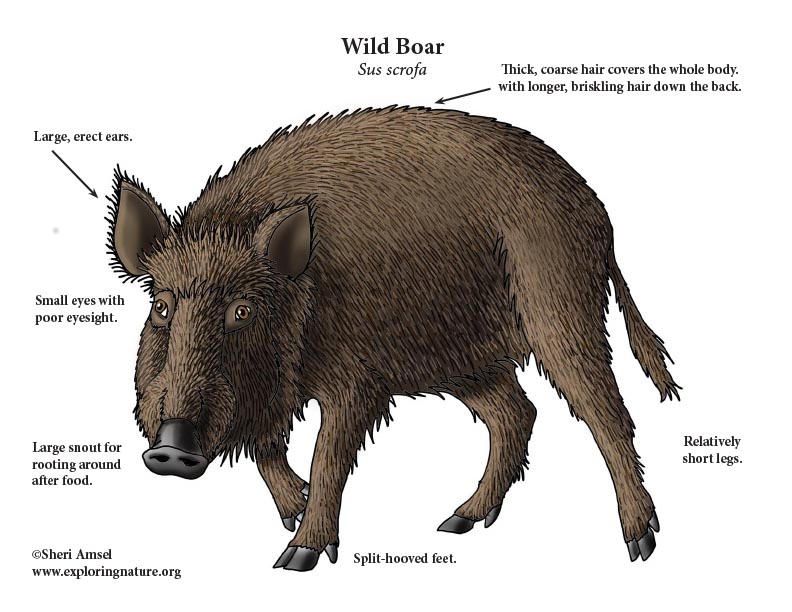

They are found in Europe, Asia, and have been introduced to southeastern United States and California. They are spreading in their introduced habitats.
They live in open, grassy areas, forests, agricultural areas, shrublands and swamps where there is water, cover for hiding and limited snowfall.
They are covered with coarse hair that ranges in colors from light to black. There is a bristling ridge of longer hair that may grow down the back. Piglets are more brownish in color with lighter stripes down their sides that fade as they grow. They have big ears and small eyes and a scraggly tail. They have upper and lower canines. The upper canines tend to be large and may even be visible when the mouth is closed. They have a good sense of smell and hearing, but poor eyesight.
Some male wild boars can reach massive sizes of more than 500 pounds (225 kg) and six feet long (183 cm), but most are smaller. They get bigger the longer they live, so older boars can become quite large. Females are somewhat smaller. They are taller at the shoulders and shorter at the hips. Their short legs make them ill-suited for living in climates with deep snow.
They are more active at night (nocturnal) in warm climates and/or warm seasons. In hotter temperatures, they stay under cover and find wet places to wallow. In cooler times of year/locations, they may feed during the day, especially at dusk. Male wild boars live alone (solitary) except when breeding. Females live in groups with their offspring. Wild boar groups are called sounders. They communicate with grunts, growls and squeals.
They eat both plants and animals (omnivorous) eating whatever is available throughout the year. They eat mostly plant matter – roots, plants, fruits, seeds and nuts and will go after agricultural crops. They will also eat small animals, bugs, eggs and even dead animals (carrion).
Their main predator is people. As wild boar populations spread into new habitats, including agricultural areas, they can be destructive and are trapped and hunted. They are also taken by bears, mountain lions, coyotes and bobcats when younger.
Females are pregnant (gestation) for about 4 months. They have about 6 piglets in each litter. They nurse for 2 - 3 months. They may have two litters per year. Most piglets do not survive to adulthood. Females can become pregnant before they are even a year old (at about 10 months). Female piglets stay with their mother’s group. Male piglets leave after 1-2 years to live on their own. They only come back to a group as adults to breed with females. Males will compete for access to breed with a group of females. They do not help raise young.
It is thought that wild boar can live up to 10 years in the wild, though most do not live that long. In captivity, they live much longer.
They are not endangered.
Kingdom: Animalia
Phylum: Chordata
Subphylum: Vertebrata
Class: Mammalia
Order: Artiodactyla
Family: Suidae
Genus: Sus
Species: Sus scrofa
When you research information you must cite the reference. Citing for websites is different from citing from books, magazines and periodicals. The style of citing shown here is from the MLA Style Citations (Modern Language Association).
When citing a WEBSITE the general format is as follows.
Author Last Name, First Name(s). "Title: Subtitle of Part of Web Page, if appropriate." Title: Subtitle: Section of Page if appropriate. Sponsoring/Publishing Agency, If Given. Additional significant descriptive information. Date of Electronic Publication or other Date, such as Last Updated. Day Month Year of access < URL >.
Amsel, Sheri. "Boar (Wild)" Exploring Nature Educational Resource ©2005-2024. December 14, 2024
< http://www.exploringnature.org/db/view/Wild-Boar >

